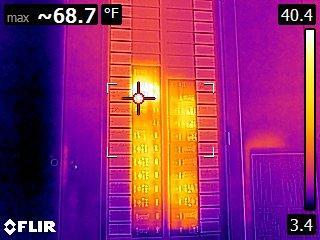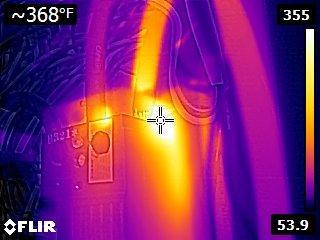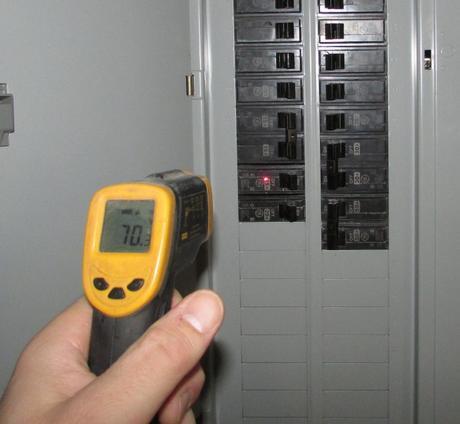When we do an infrared inspection along with a home inspection, one of the extra things we do is to go around the house and turn on everything that's built into the home that uses electricity, to help determine if there are any overloaded circuits or overheated connections inside the main panel. With an infrared camera, all it takes is a quick scan of the panel to see if there are any hot spots.
If we do identify a hot spot in the panel, the next step is to figure out if it's a problem or not. We're usually not concerned with the exact temperature of the circuit breaker, because it's all relative. Even with no load on anything, arc-fault circuit breakers run a little warmer than anything else in the panel; that's never an issue. When we run an electric oven and turn the stove-top burners on, the circuit breaker and wires always get hot. That's not a problem either. Usually when I find a problem with a hot circuit, it's the result of the circuit being overloaded.
For example, last week while inspecting a new-construction home in Hugo, I found a circuit breaker that was significantly warmer than all the rest of the breakers.

My infrared camera showed the circuit breaker to be nearly 70° Fahrenheit, while the ambient temperature was close to 0°... but again, the exact temperature wasn't important. The important question was whether or not this circuit was overloaded. To figure that out, I used my clamp-meter to see how much current was passing through the circuit breaker.

In this case, it was about 23 amps going through a 20 amp circuit breaker.
What's allowable is a continuous load that is 80% of the circuit breaker's rating. In other words, no more than 16 amps on a 20 amp breaker. Click here for more details on sizing a circuit breaker. This circuit was clearly overloaded. The fix was to have another circuit added.
In some cases, however, we find wires or circuit breakers that are so hot that we don't even bother testing the amperage; we just say it's overheated, it's a fire hazard, get it fixed. That generally applies to circuit breakers or wires over 140° Fahrenheit. The images below show a couple of nice examples of this.


Aren't infrared cameras great? I think they're great. This test doesn't require the use of an infrared camera though; I've heard of some home inspectors using an infrared thermometer to slowly scan an electric panel to look for hot spots, but I've never had much luck with that myself.

I've tried using my cheap infrared thermometer on known hot spots on panels, and they do not jump out. In other words, I don't recommend using an infrared thermometer in lieu of an infrared camera. There are a few new "imaging IR thermometers" on the market today, such as the Flir TG165 and the Fluke VT02. As far as I can tell, these are simply stripped-down infrared cameras which would probably do a good job of identifying hot breakers, but so would the infrared cameras that are designed for mobile phones, such as the Flir One or the Seek Thermal.
Author: Reuben Saltzman, Structure Tech Home Inspections




